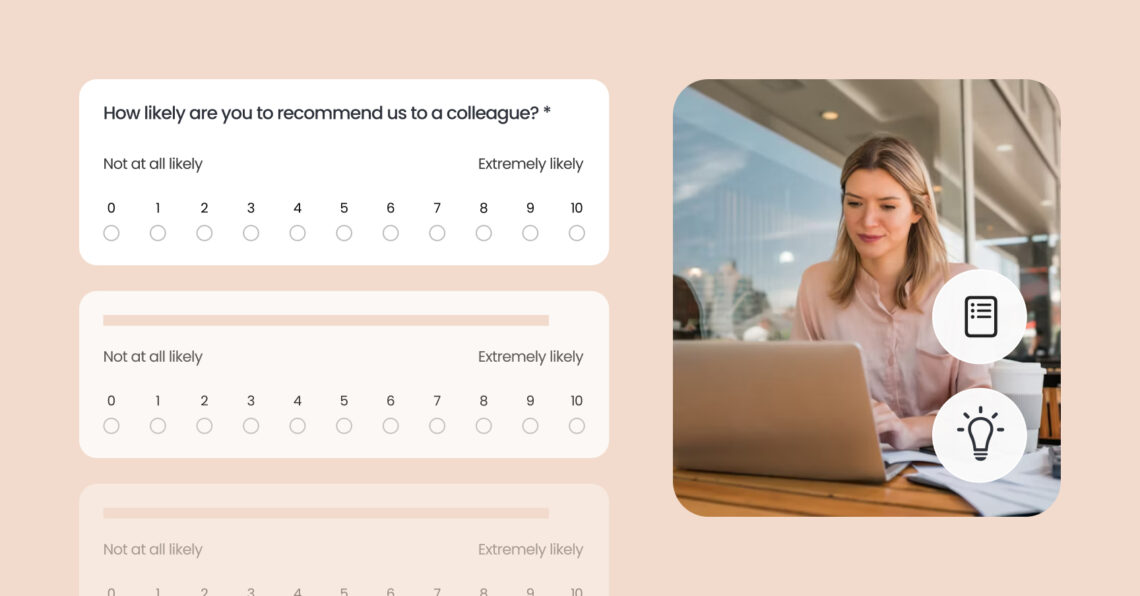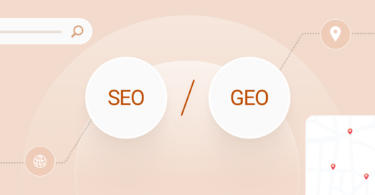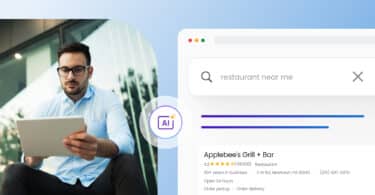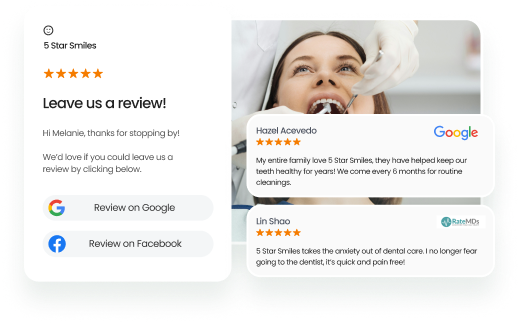Businesses that know what questions to ask during a survey see higher response rates, gain deeper customer insights, and unlock new growth opportunities. We also have survey question examples to demonstrate how impactful good survey questions can be.
Many businesses launch surveys with high hopes, only to realize they’re missing the mark due to poorly designed questions. Creating surveys sounds simple—until you’re left wondering why your feedback feels vague, incomplete, or just plain unusable.
Here’s the good news: mastering survey questions doesn’t have to be complicated; you only need a little inspiration. In this guide, we’ll share 50+ expertly crafted survey question examples, show you how to choose the correct survey question types, and help you avoid the common mistakes that lead to survey fatigue.
Build Customer Feedback Surveys that Yield Results
Want to see the impact of Birdeye on your business? Watch the Free Demo Now.
Table of contents
- Why are well-crafted survey questions essential?
- What makes a good survey question?
- What are the different types of survey questions?
- What are the best survey question examples by use case?
- How to create survey questions? Top tips to know
- What are survey design best practices?
- How do Birdeye Surveys help you build better surveys?
- Use the best survey question examples for accurate customer feedback
- FAQs on survey questions examples
- Start boosting your survey response rates with Birdeye
Why are well-crafted survey questions essential?
Your survey results are only as good as the questions you ask. A well-designed survey can drive business decisions, improve customer experience, and increase employee engagement.
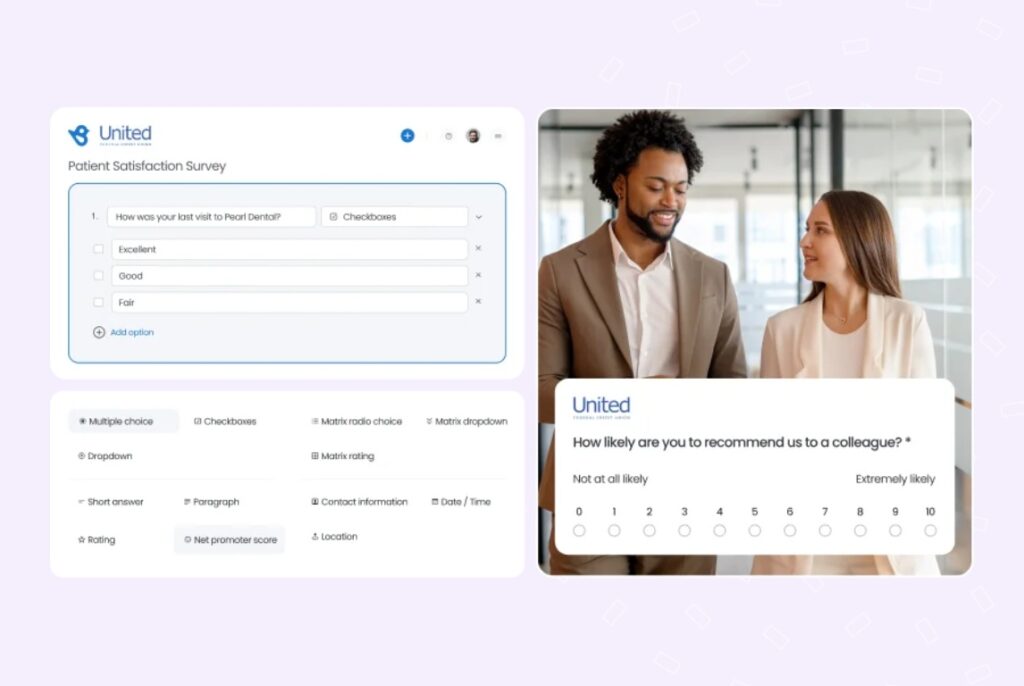
Here’s why focusing on what survey questions to ask matters:
- Drives accurate, actionable insights: Clear and targeted questions help uncover genuine customer sentiments, behaviors, and preferences that can shape your strategies.
- Improves response rates: Well-structured surveys show respect for the respondent’s time, leading to higher completion rates.
- Reduces survey fatigue: Balanced question types prevent overwhelm and keep respondents engaged.
- Minimizes bias: Carefully worded questions avoid leading or loaded language, resulting in more objective feedback.
- Enhances decision-making: Reliable survey data supports informed decisions, whether you’re refining a product or improving workplace culture.
- Boosts customer loyalty: Asking the right questions demonstrates that you value customer opinions, increasing brand trust and satisfaction.
- Saves time and resources: High-quality questions reduce the need for repeated surveys by getting it right the first time.
By mastering the fundamentals of effective survey design, you can collect data and gain meaningful insights that help your business grow.
What makes a good survey question?
A good survey question is clear, focused, and designed to elicit helpful information. It guides respondents to share honest, meaningful feedback without confusion or bias.
Here’s what defines a good survey question:
- Clarity: Avoid ambiguity or jargon. For example, instead of asking, “How was your recent experience with our service delivery system?” you could ask, “How satisfied are you with the speed of your last delivery?”
- Brevity: Keep it short and direct. Long-winded questions can confuse respondents. For instance, “Would you agree that based on your recent interaction with our customer support team, you were able to resolve your issue promptly and to your satisfaction?” can be simplified to “Did our support team resolve your issue promptly?”
- Neutrality: Prevent bias by writing objective questions. Avoid loaded phrases like “Why do you think our service is the best?” Instead, ask, “How would you rate your satisfaction with our service?”
- Relevance: Focus on questions aligned with your survey’s objective. If measuring customer service effectiveness, avoid including questions about unrelated product features.
Real-world example: If a dental business used the question: “Did you find our website helpful and enjoyable to use?” This double-barreled question mixed two ideas (helpful and enjoyable), confusing users who might have found the site helpful but not enjoyable. By splitting it into two questions—one about usefulness and another about enjoyment—they saw clearer, more actionable insights.
Pro tip: Always put yourself in the respondent’s shoes. Would you quickly understand and feel comfortable answering the question? If not, rework it. You should also constantly monitor survey response rates to different survey questions to see what brings out the best response from your customers.
What are the different types of survey questions?
Before we dive into the survey questions examples that can set your business apart in customer research, let’s explore the main types of survey questions.
Here are the main types of survey questions with examples:
| Survey question type | Benefits | Best Used For |
| Open-ended | Captures detailed, qualitative insights. | Customer feedback, product suggestions, experience summaries. |
| Closed-ended | Provides quick, binary responses; easy to analyze. | Yes/No satisfaction checks, pre/post service follow-ups. |
| Multiple-choice | Offers structured options, helps identify patterns. | Demographic surveys, customer preference polling. |
| Likert scale | Measures degrees of opinion, agreement, or frequency. | Brand perception, employee engagement, satisfaction tracking. |
| Rating scale | Quantifies satisfaction or performance. | NPS surveys, usability scoring, feature evaluation. |
| Demographic | Helps segment audiences based on personal traits. | Audience profiling, target market research. |
| Nominal | Categorizes responses without any ranking. | Regional segmentation, brand preferences, communication channels. |
Let us explore each of these question types in detail.
1. Open-ended questions
These allow respondents to express thoughts in their own words and provide in-depth information about your business, products, and services. However, it is important to know when to use it.
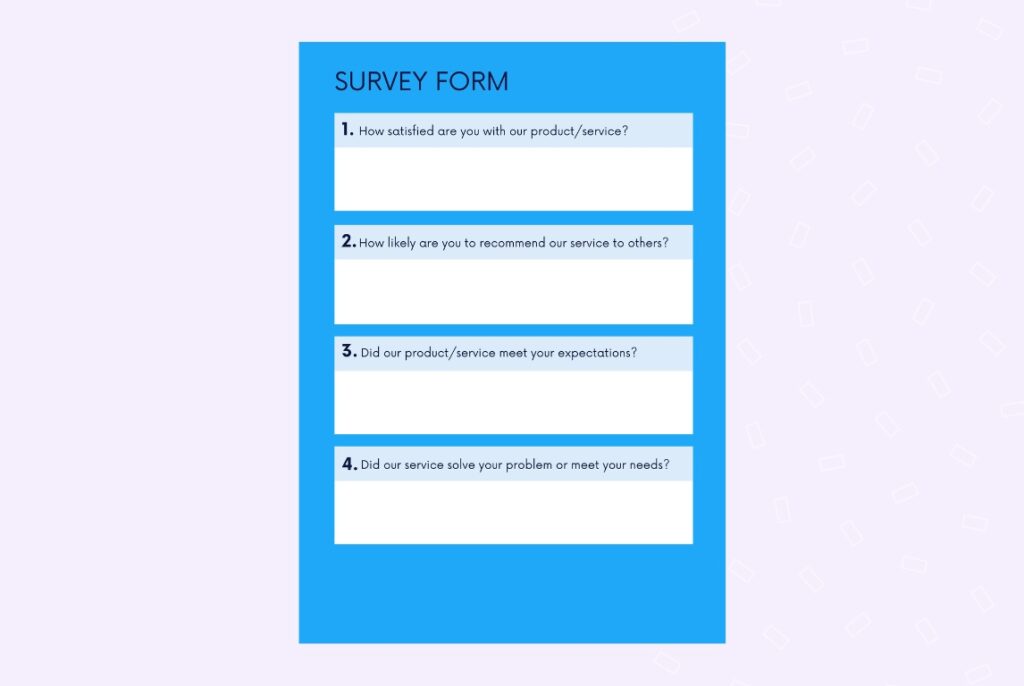
Open-ended survey questions are ideal for qualitative data research in marketing surveys and personal customer surveys, while they may not be the best choice for NPS surveys or other quantitative data research.
Open-ended survey question examples
- “What could we improve in our service?”
- “Describe your overall experience with our brand.”
- “What did you like the most about our products?”
2. Closed-ended questions
These survey questions are designed to get definite answers and allow respondents to choose from Yes or No responses without having to come up with an answer themselves. This is ideal for quantitative data research and makes it easy for businesses to spot patterns among survey responses with simple Yes or No questions.
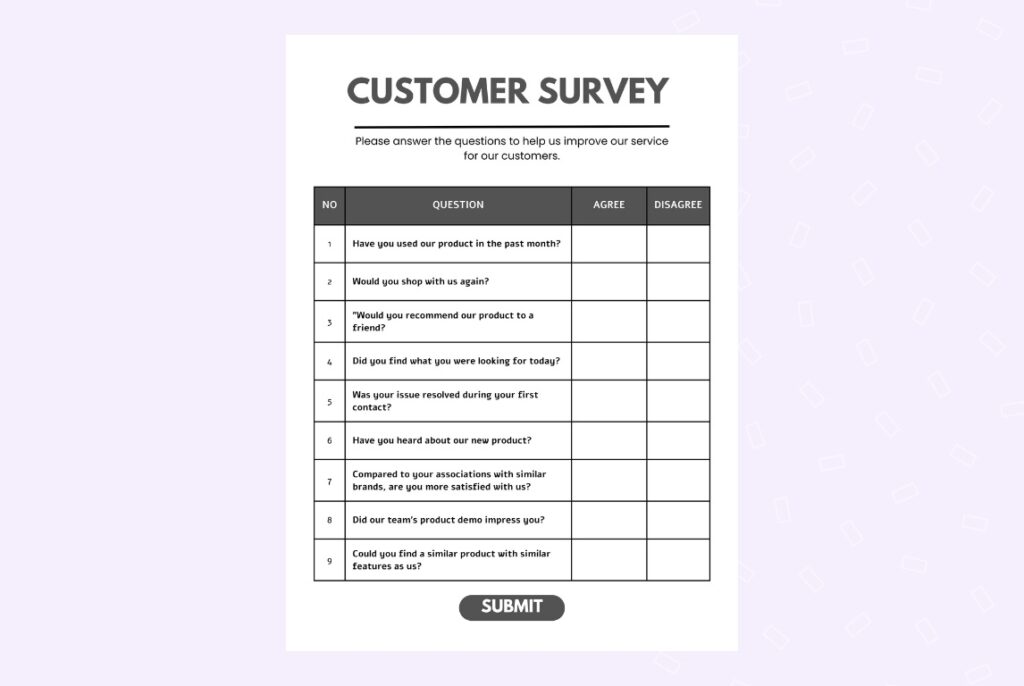
Closed-ended survey question examples
- “Have you used our product in the past month? (Yes/No)”
- “Would you shop with us again? (Yes/No)”
- “Would you recommend our product to a friend? (Yes/No)”
- “Did you find what you were looking for today? (Yes/No)”
- “Was your issue resolved during your first contact? (Yes/No)”
3. Multiple-choice questions
Multiple-choice questions are closed-ended questions that allow respondents to choose from a predefined set of responses for each survey question. They are the most common type of question in NPS surveys and pulse surveys.
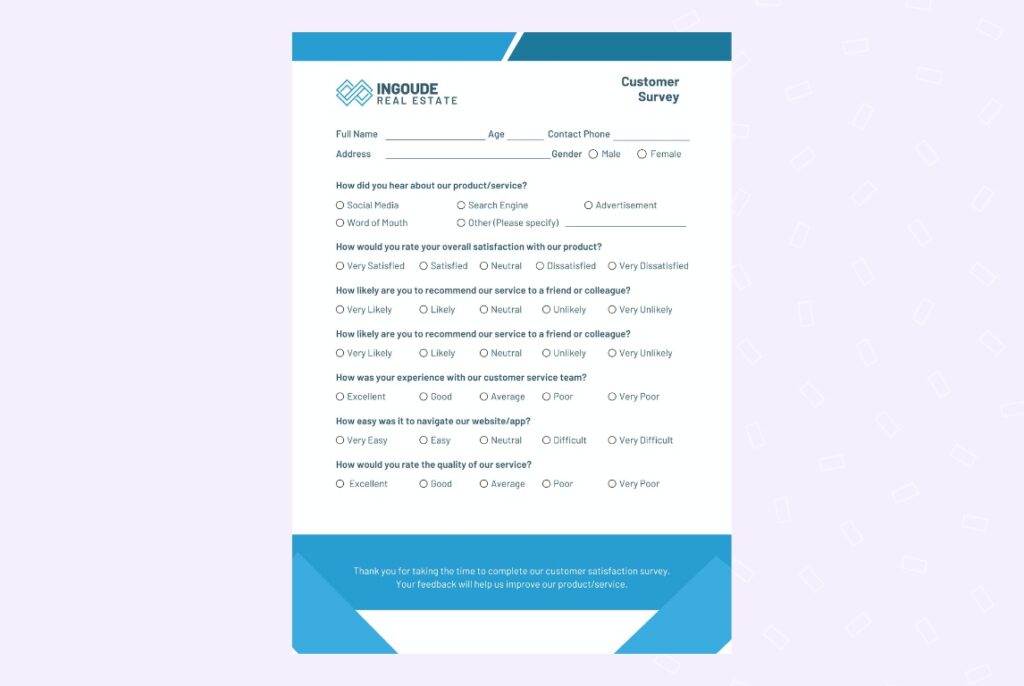
Multiple-choice survey question examples
- “Which of the following products have you used? (Product A, Product B, Product C)”
- “What is your preferred method of communication? (Phone, Email, Chat, In-person)”
- “Which age group do you belong to? (18-24, 25-34, 35-44, 45+)”
- “What is your primary reason for visiting our website? (Research, Purchase, Support, Other)”
4. Likert scale questions
Likert scale questions help businesses measure opinions or attitudes by presenting them with statements and recording their responses on a sliding scale of satisfaction. It can help you understand what customers like about your business and accurately measure brand perception.
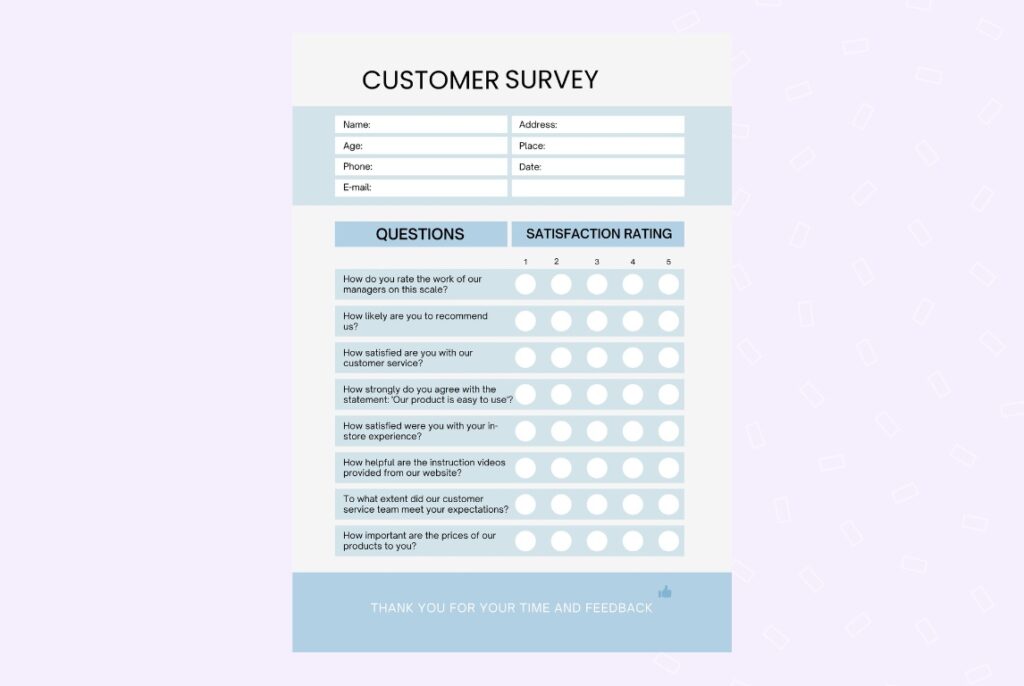
Likert scale survey question examples
- “How likely are you to recommend us? (1 = Not at all likely, 5 = Extremely likely)”
- “How satisfied are you with our customer service? (1 = Very dissatisfied, 5 = Very satisfied)”
- “How strongly do you agree with the statement: ‘Our product is easy to use’? (1 = Strongly disagree, 5 = Strongly Agree)”
- “How frequently do you use our service? (1 = Never, 5 = Always)”
5. Rating scale questions
These survey questions help businesses measure customer satisfaction by allowing them to rate metrics or business offerings on a scale of 1 to 10.
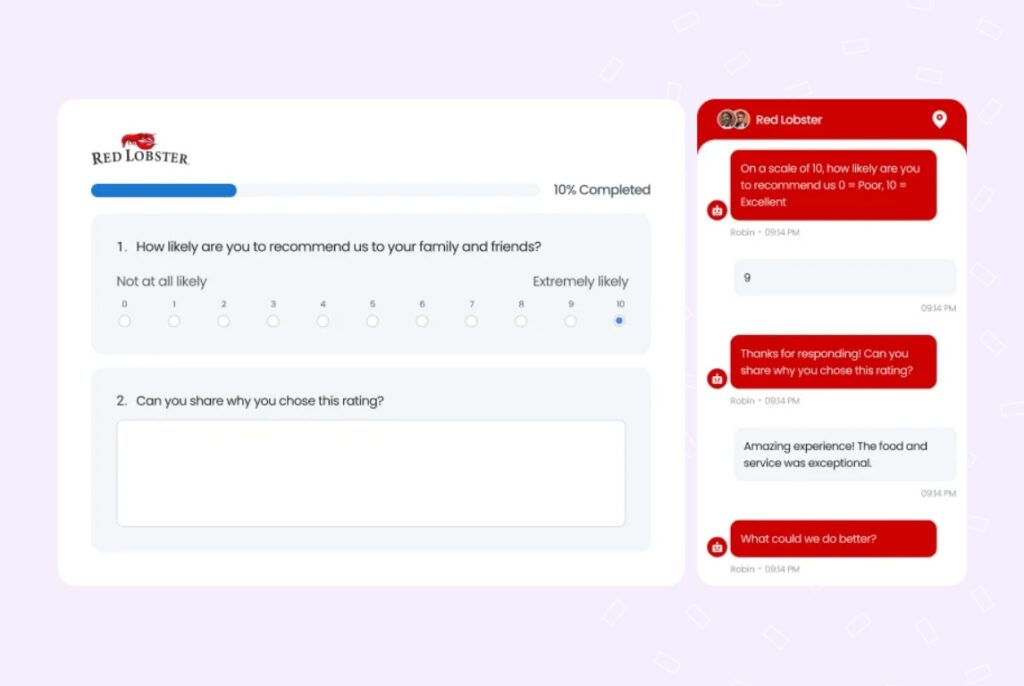
Rating scale survey question examples
- “Rate your satisfaction with our support (1 to 10).”
- “On a scale of 1 to 5 stars, how would you rate our app design?”
- “How likely are you to purchase from us again? (0 to 10)”
- “Rate the usefulness of our knowledge base. (1 = Not useful, 10 = Extremely useful)”
6. Demographic questions
This method allows businesses to ask survey questions about the demographics of their target audience, potential customers, and target market groups. These survey questions can play a critical role for businesses wanting to understand their ideal customer profile (ICP), core audience, and buyer personas to target.
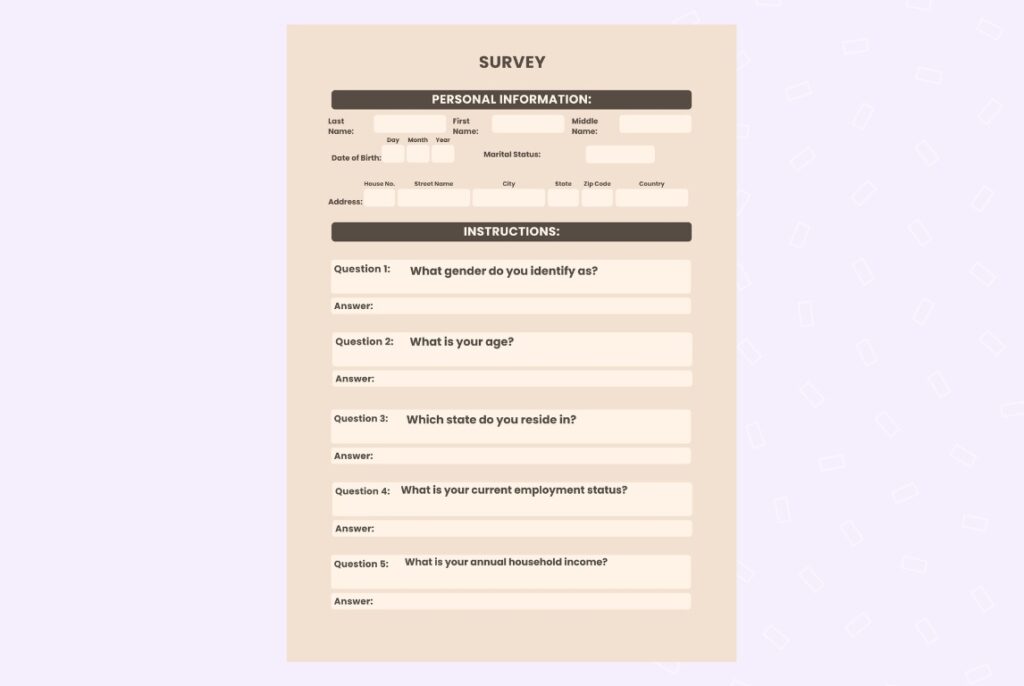
Demographic survey question examples
- “What is your age group? (Under 18, 18-24, 25-34, 35-44, 45+)”
- “What is your employment status? (Employed full-time, Part-time, Unemployed, Student, Retired)”
- “What is your highest level of education? (High school, Bachelor’s, Master’s, Doctorate)”
- “Which industry do you work in? (Healthcare, Education, Technology, Other)”
7. Nominal questions
Nominal questions belong to the closed-ended survey questions category, where survey respondents are asked to choose from various categories, and the options don’t have a natural order or ranking.
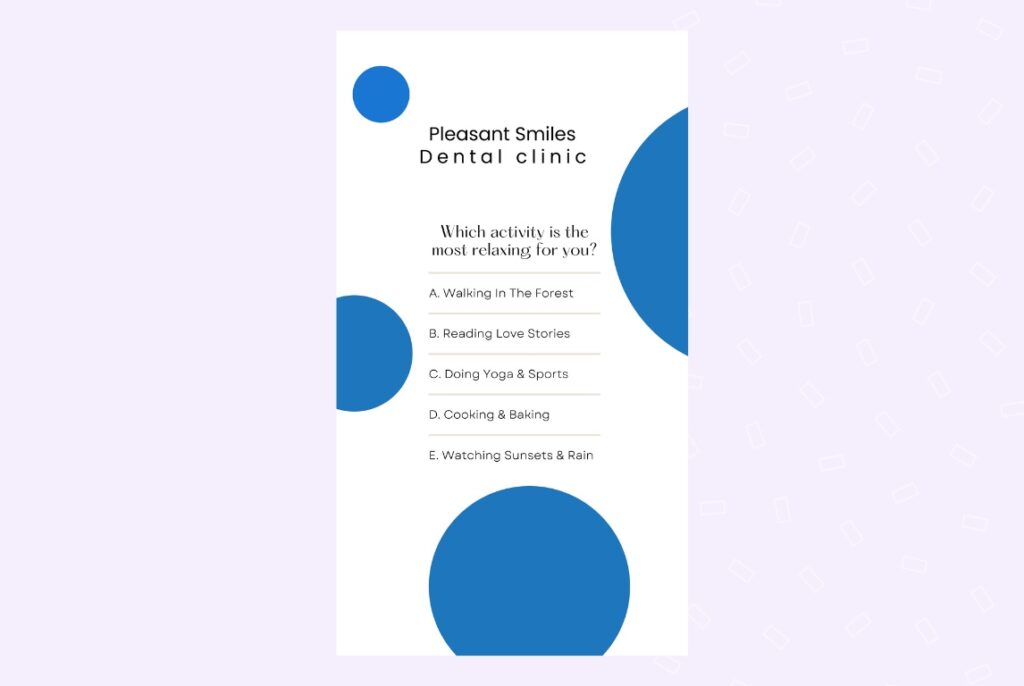
Nominal survey question examples
- “Which region do you live in? (North America, Europe, Asia, Other)”
- “What is your preferred device? (Desktop, Tablet, Mobile)”
- “Which brand do you prefer? (Brand A, Brand B, Brand C)”
- “What is your favorite communication channel? (Phone, Email, Chat, Social Media)”
What are the best survey question examples by use case?
Customer satisfaction survey examples
Customer satisfaction surveys help businesses gather direct insights on customer satisfaction, expectations, and areas for improvement. These questions are helpful across industries like healthcare, automotive, and restaurants. You can use Likert scale questions or nominal questions to collect user feedback.
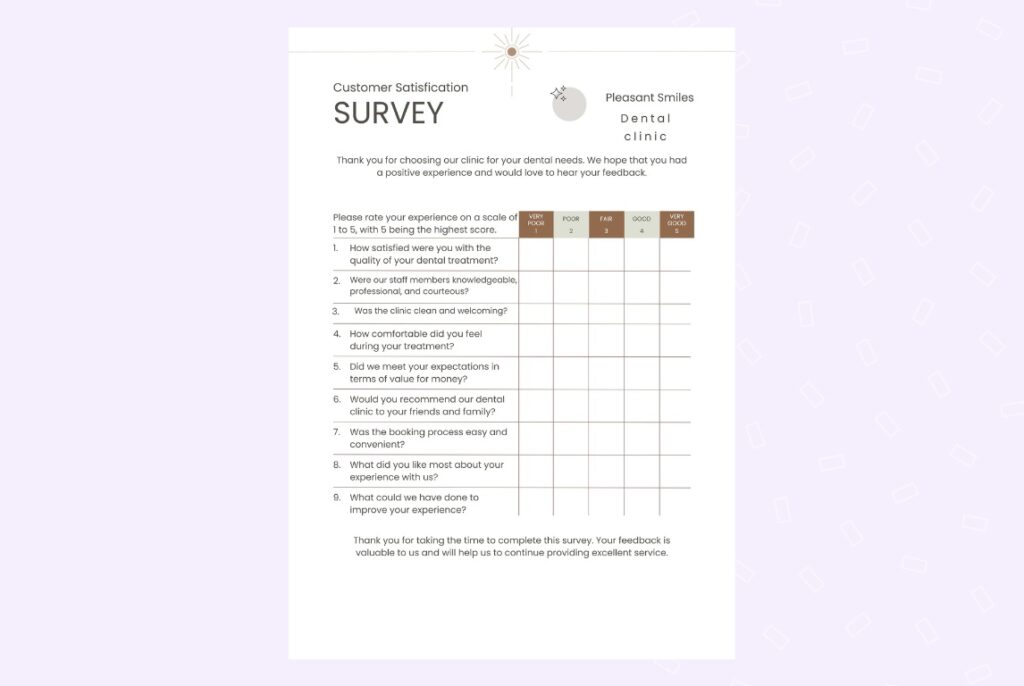
- “How satisfied are you with your recent experience at our clinic/restaurant/store?”
- “What aspect of our service stood out the most to you?”
- “Would you recommend our dental practice/property management services to others?”
- “How likely are you to return to our restaurant/self-storage facility?”
- “Did our team meet your expectations during your visit?”
- “How would you rate the quality of our automotive repair service?”
- “In your own words, how would you describe our staff’s helpfulness?”
- “What could we improve in your next visit to our healthcare center?”
- “How would you rate the cleanliness and comfort of our facility?”
- “How likely are you to choose our business again?”
Employee & team member engagement survey examples
These surveys gauge how employees feel about their work environment and management. Employee feedback surveys are applicable to all industries, especially for healthcare, property management, and automotive service centers.
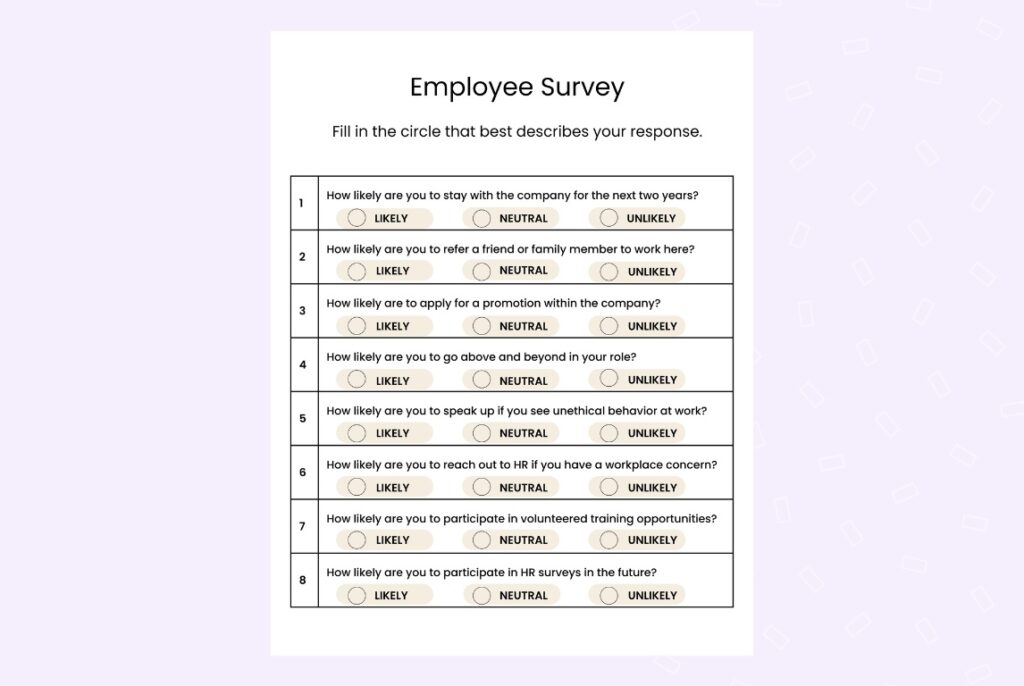
- “How supported do you feel by your immediate manager?”
- “Do you have access to the resources you need to perform your job well?”
- “How motivated do you feel in your current role at the dental clinic/property agency/auto shop?”
- “Do you feel recognized for your contributions at work?”
- “How would you rate communication within your team?”
- “How comfortable are you sharing feedback with leadership?”
- “Do you see opportunities for career growth in this organization?”
- “How likely are you to recommend this organization to others as a great workplace?”
- “How valued do you feel for the work you do each day?”
- “What improvements would make your work environment better?”
Product feedback survey questions examples
Product feedback survey questions help businesses gather user input on specific products or services, including those used by automotive shops, dental practices, and property managers.
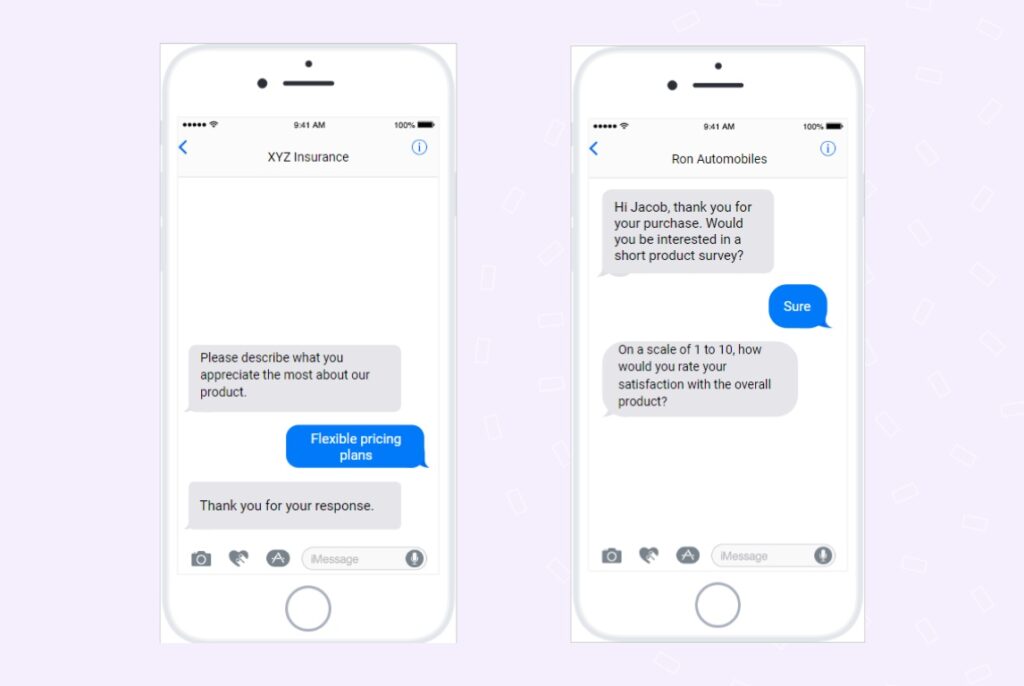
- “How easy was using our online booking system for your appointment/rental/service?”
- “Which features of our self-storage booking platform did you find most helpful?”
- “What additional features would you like to see in our customer portal?”
- “How satisfied are you with the quality of our automotive repair services?”
- “Did the product/service meet your expectations?”
- “How would you rate the affordability of our services?”
- “Would you consider upgrading to a higher service package?”
- “What improvements would make our dental/automotive/property services better for you?”
- “How user-friendly was our self-check-in kiosk at our healthcare or self-storage facility?”
- “Would you recommend our product/service to a colleague or friend?”
Event & guest satisfaction survey questions examples
These questions help evaluate an event’s success for attendees, whether in a healthcare seminar, real estate open house, or a restaurant-hosted community event.
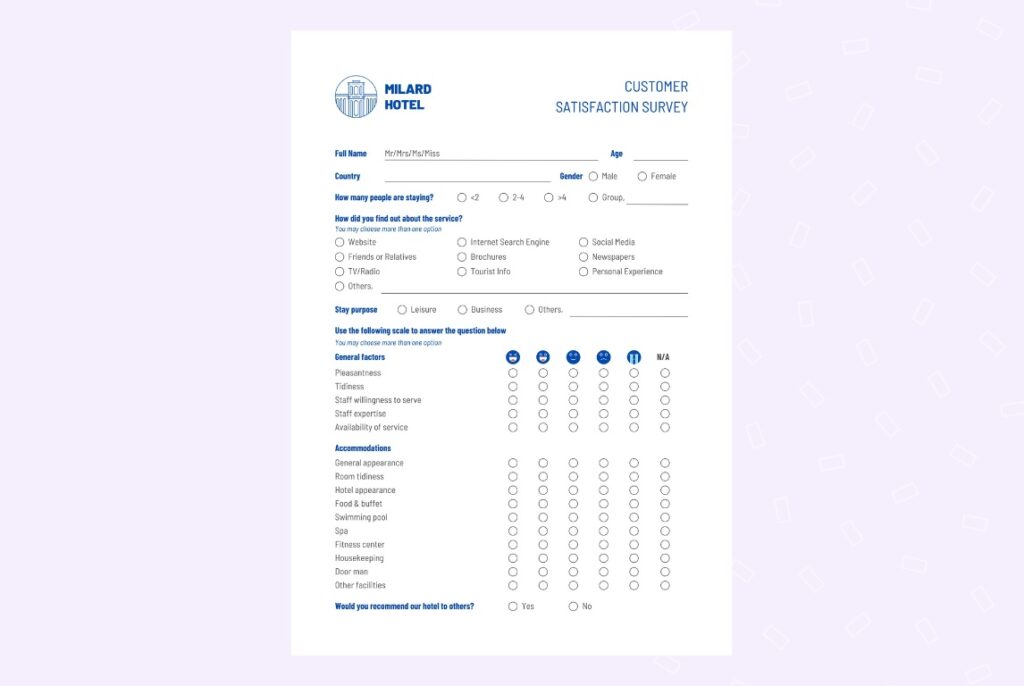
- “How satisfied were you with the overall event experience?”
- “Did the event meet your expectations in terms of content and organization?”
- “How relevant was the event content to your interests or profession?”
- “How would you rate the quality of the speakers or presentations?”
- “Was the venue (clinic, dealership, restaurant) comfortable and accessible?”
- “How likely are you to attend our events in the future?”
- “Were you able to network or connect with other attendees during the event?”
- “How would you rate the hospitality provided during the event?”
- “What could we improve for our next event?”
- “Did the event provide valuable takeaways for your business or personal needs?”
Website UX survey examples
These questions focus on understanding how users interact with your digital touchpoints, such as healthcare portals, property management websites, or restaurant reservation platforms.
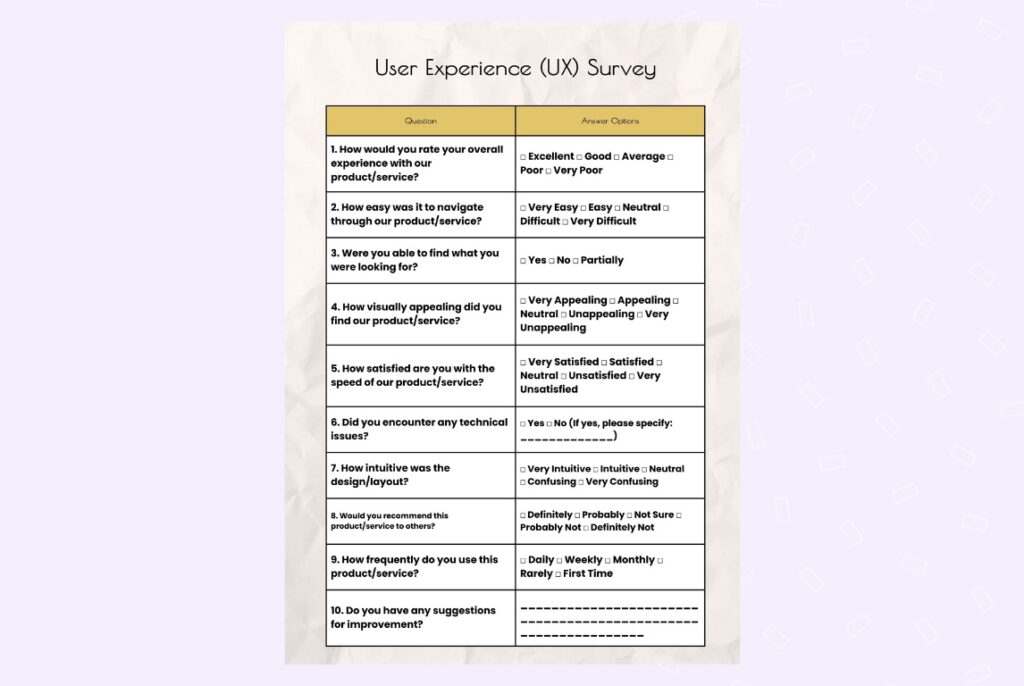
- “How easy was navigating our website and finding the information you needed?”
- “Was the online appointment booking process simple and efficient?”
- “How satisfied are you with the mobile-friendliness of our website?”
- “Were you able to find answers to your questions without contacting support?”
- “How would you rate the loading speed of our website?”
- “Did the images and descriptions of our services/products meet your expectations?”
- “How easy was locating contact information or business hours online?”
- “Would you recommend our website to others looking for similar services?”
- “How visually appealing is the design of our website?”
- “What would you improve about your online experience with us?”
Customer service survey questions examples
These surveys help measure how well your team is supporting customers. They are relevant to sectors like rental agencies, dental offices, and auto repair shops.

- “How satisfied are you with the assistance you received today?”
- “Was your issue resolved to your satisfaction?”
- “How professional and courteous was the staff member who assisted you?”
- “How quickly was your issue or question addressed?”
- “How knowledgeable was the representative you spoke with?”
- “How likely are you to recommend our customer service to others?”
- “How clearly did our team provide the instructions or information?”
- “Was the follow-up after your visit or service timely and helpful?”
- “How easy was contacting us for support (phone, email, chat)?”
- “What suggestions do you have to improve our customer service experience?”
Customer research survey questions examples
These questions help businesses understand customer behaviors during a brand survey and decision-making across the healthcare, automotive, property, and hospitality sectors.
- “How did you first hear about our dental clinic/property management company/auto repair shop?”
- “What was the main reason for choosing our services over competitors?”
- “How long have you been using services like ours (in healthcare, self-storage, rentals)?”
- “What factors were most important in your purchase decision?”
- “Which other businesses did you consider before choosing us?”
- “What is your preferred method of receiving promotions or offers?”
- “How frequently do you use services like ours in a year?”
- “What would motivate you to try the additional services we offer?”
- “What type of offers or loyalty programs do you value the most?”
- “How likely are you to recommend our services based on your experience so far?”
Pulse survey question examples
Pulse surveys are short, regular surveys that track employee or user sentiment over time. They are widely used across industries.
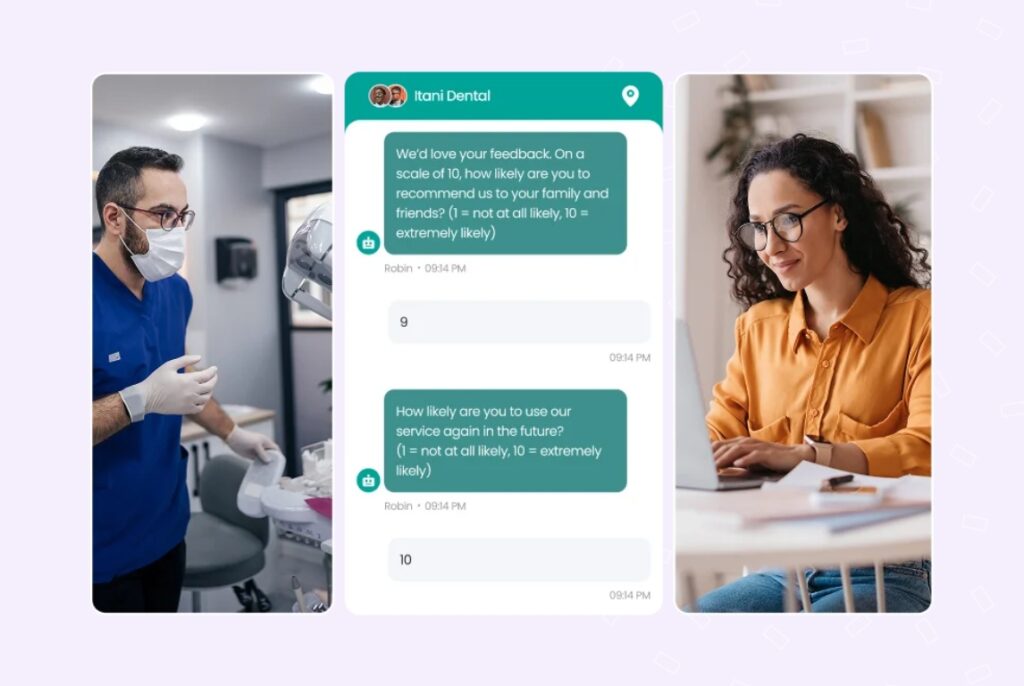
- “How satisfied are you with your workload this week?”
- “Do you feel you received sufficient support from your team/manager this week?”
- “How confident do you feel about completing your tasks this week?”
- “How well do you feel your concerns were addressed in the last seven days?”
- “How would you rate communication within the organization this week?”
- “How motivated are you feeling today at work?”
- “Have you experienced any roadblocks or challenges this week?”
- “How connected do you feel to your team or organization today?”
- “How would you rate your overall stress level this week?”
- “What’s one thing that could improve your workday right now?”
How to create survey questions? Top tips to know
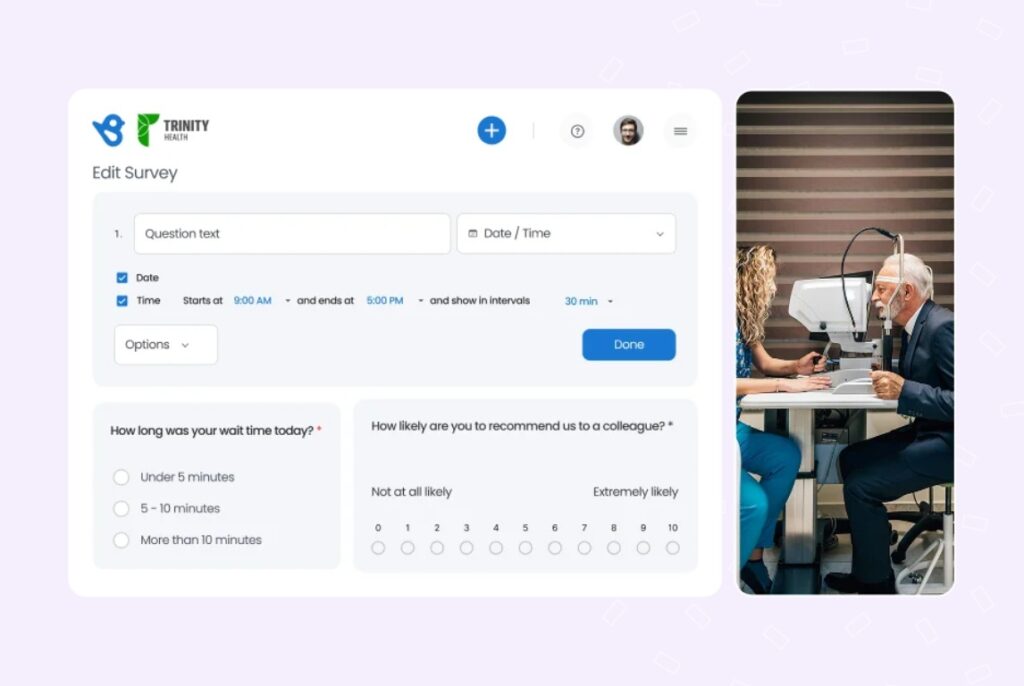
To ensure your survey questions yield accurate and meaningful results, follow these best practices:
- Craft questions that are clear, concise, and easy to understand.
- Avoid using technical jargon or complex language that may confuse participants.
- When creating multiple-choice or rating scale questions, ensure the response options are balanced and cover the entire range of possible answers.
- Arrange survey questions in a logical and sequential manner to maintain the flow.
- Consider how one question may influence the perception or response to subsequent questions.
- Avoid combining multiple ideas or concepts in a single question.
- Share the survey with a small group and gather feedback to identify any areas of confusion or improvement.
Pro tip: Long surveys with numerous questions can lead to survey fatigue and lower response rates. Keep your surveys short, focused, and relevant to maximize participant engagement and completion rates. You can also add a progress bar to keep the users engaged.
What are survey design best practices?
While the questions are essential, the design matters a lot. It helps your customers provide feedback accurately so that your business can better understand user behavior.

Here are a few guidelines to follow:
- Keep surveys short: Aim for 5-10 questions.
- Personalize when possible: Address survey respondents by name.
- Make surveys mobile-friendly: Optimize for all devices.
- Use a mix of question types: Combine open and closed-ended formats.
- Follow-up on feedback: Show respondents their input matters.
How do Birdeye Surveys help you build better surveys?
Building a good survey can be challenging, especially when you have thousands of customers across multiple locations.
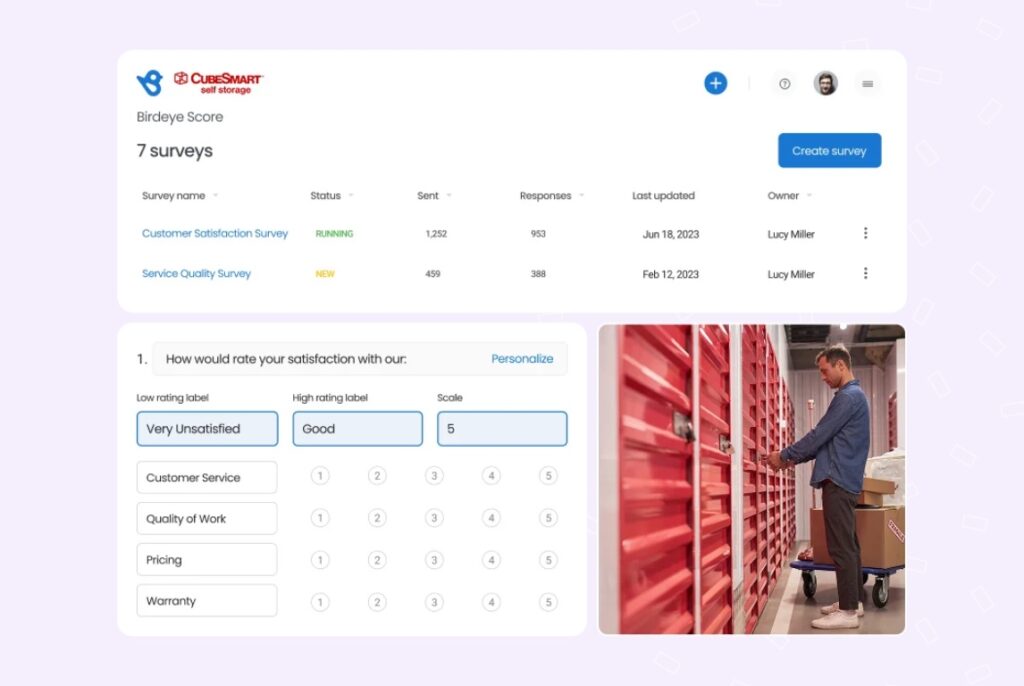
However, with Birdeye Surveys, you can automate this process with:
- Pre-built templates for customer feedback, employee engagement, NPS, and more.
- AI-powered suggestions to automatically generate relevant survey questions.
- Omnichannel distribution (email, SMS, website, kiosk).
- Automated workflows to trigger surveys at key customer journey stages.
- Advanced analytics with real-time reporting and actionable recommendations.
Use the best survey question examples for accurate customer feedback
Crafting impactful surveys is more than just collecting responses—it’s about unlocking valuable insights that help your business grow. The right mix of survey questions allows you to understand customer preferences better, measure satisfaction, improve internal processes, and identify areas of opportunity.
By applying the proven survey question examples outlined in this guide, you can boost engagement, gather meaningful data, and drive more intelligent decisions. Whether running a quick pulse survey, measuring customer satisfaction, or gathering product feedback, choosing the right survey questions will help you collect more accurate and actionable insights.
Combined with a platform like Birdeye Surveys, you can elevate your survey strategy
FAQs on survey questions examples
Customer surveys are a method of collecting feedback from customers. Data from these surveys help businesses measure satisfaction, perform market research, gauge expectations, and make critical business decisions based on the intel.
Keep surveys concise to maintain participant engagement. Depending on the complexity of the topic, aim for approximately less than 10 questions to ensure data quality and completion rates.
– If it’s a text messaging survey, keep it or 2 max.
– For emails, 5-8 max.
Online surveys offer convenience and scalability, but the effectiveness of survey methods depends on various factors, such as the target audience, research goals, and data requirements.
Choose the method that best suits your specific needs.
To analyze open-ended responses, use techniques such as thematic analysis, sentiment analysis, and content analysis. These methods help identify patterns, common themes, and sentiments respondents express.
Questions that are clear, objective, and relevant to your goal. For example, “How likely are you to recommend us?”
Start with a clear objective, use various question types, and avoid leading or double-barreled questions.
Short, frequent questions are used to gauge real-time employee or customer sentiment. For example: “How do you feel about your workload this week?”
Personalize the survey, keep it short, distribute via preferred channels, and offer incentives if appropriate.
Start boosting your survey response rates with Birdeye
Looking to take your surveys to the next level? Birdeye Surveys helps businesses like yours create customized surveys that drive better response rates and richer feedback.
Whether you need to launch a customer satisfaction survey, a pulse survey, or an NPS survey, Birdeye makes it easy.
With AI-powered question recommendations, pre-built templates, and omnichannel distribution (email, SMS, website, and more), you’ll collect actionable insights faster.
Plus, real-time analytics ensure you can make data-backed decisions with confidence.
Get started with Birdeye Surveys and start capturing impactful feedback today! Watch the free demo now.

Originally published
